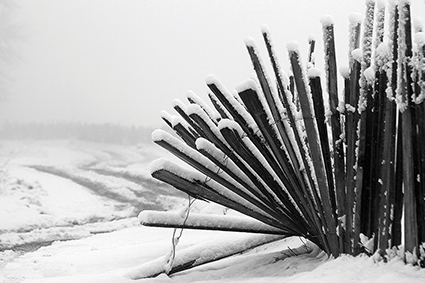More Monochrome Haiku: Etseri, Svaneti
Blog
Yes, we knew the snow would come again. This time there has been enough of it that it might just stay until the next layer arrives. If so, and the trend continues, then we’ll be stuck with it until spring warming starts reversing the trend, despite the near-1 (perfect reflection of all radiation) albedo I mentioned in last week’s article.
Because this last snowfall came while the temperatures were still very mild, it was extra-sticky: just right for making snowballs and snowmen! It also adhered to everything: trees, fences and so on. It wasn’t going to last long in such warmth, though, so I took a couple of hours and walked up the road past our house toward Becho, marveling in and shooting images of the haiku-like minimalism which winter brings. Color is almost absent, and things are reduced to some kind of essences of themselves. For this, I have found, black and white photography is best. Although I do always shoot in color, because colorizing a colorless image is much harder than stripping the hues from a color one, I almost always end up with a grayscale image in these settings. Color is more of a distraction from form, light and shadows.
The snow and ice do indeed have so many forms that I’m not too surprised that people who live in mostly winter conditions have many more words for H2O’s solid forms than we westerners do. From confectionary, spun-sugar or eggshell delicacy to miles-thick Titanic-destroying bergs, from purest white to deadly cold blues, the ranges are seemingly endless.
This day I was concentrating on fences, which here are nicely handmade from wooden slats wired together and preferably oak posts, giving them a pleasingly non-uniform look. There are hardly any colors already, especially with wood which has been bleached by the sun long enough to lose most of its warmer tones and reduced to grays. So there is rhythm, from the structures’ repeating forms, and variation in their heights, thicknesses and so on. A perfect mix.
I call these images photographic haiku after the minimalist three-line Japanese poems because there is hardly anything to them, but not nothing. In them, I strive to capture something small but significant, the quintessence of the subjects, covered or revealed by their silent veils of white. Here is an example of a haiku by the master of the genre, Basho, called The First Snow:
The first snow
the leaves of the daffodil
bending together
That’s all. While I’m not a practitioner of Zen, I do appreciate the sparseness of haiku, the statement about just one thing. This is what I’m aiming for in these images, which I find more of every winter. I don’t have to go far; I can start in my own fenced-in yard, and don’t even have to leave it at all to find what I’m looking for. But I do, because I’m a bit greedy for more. This time I ended up taking 120 frames on my digital camera.
These things, the making of so many images and then the long descriptions of them and the process, are actually somewhat against what haiku is about, however If I was really serious about it even in pictorial form, I would present the images with no writing whatsoever, save perhaps the permitted titles, and let them speak for themselves, whether in three lines of a few syllables each or in endless effortless volumes. After all, a single photo is supposed to be worth a thousand words. Is it not?
Tony Hanmer has lived in Georgia since 1999, in Svaneti since 2007, and been a weekly writer for GT since early 2011. He runs the “Svaneti Renaissance” Facebook group, now with nearly 2000 members, at www.facebook.com/groups/SvanetiRenaissance/
He and his wife also run their own guest house in Etseri:
www.facebook.com/hanmer.house.svaneti
By Tony Hanmer












